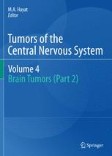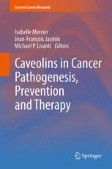Search
Search Results
-
Subependymal Giant Cell Astrocytoma: Role of mTOR Pathway and Its Inhibitors
Subependymal giant cell astrocytoma is a distinct brain tumor growing near the foramen of Monro. Although histologically benign, these tumors may...
-
Isolation and Characterization of Cancer Stem Cells from Dog Glioblastoma
There is increasing evidence in some malignancies that the tumor clone is heterogeneous (phenotypically and functionally) in regard to proliferation...
-
Subependymal Giant Cell Astrocytoma: Treatment
Tuberous sclerosis complex (TSC), a relatively common genetic disorder, is associated with inactivation of tumor suppressor genes. Hence, tumors of...
-
Gangliogliomas and Other Low Grade Neuronal Neoplasms of the Central Nervous System: Diagnosis, Treatment, and Prognosis
Glioneuronal tumors of the brain and spinal cord are relatively uncommon but highly interesting neoplasms, whose very existence provides support for...
-
Malignant Astrocytomas of the Spinal Cord: Clinicopathologic Parameters
Malignant spinal cord astrocytomas are uncommon neoplasms that typically manifest with the acute onset of symptoms such as pain accompanied by motor...
-
Epilepsy-Associated Brain Tumors: Diagnosis Using Magnetic Resonance Imaging
In 20–30% of patients with long-term drug-resistant epilepsy neuroepithelial tumours are found. Glioneuronal tumours are much more frequent than...
-
Caveolin-1 in Brain Tumors
Increasing evidences in the last years suggested a possible involvement of caveolin-1 (cav-1) in the biology of brain tumors. In vitro studies on...
-
Gangliogliomas: Molecular Pathogenesis and Epileptogenesis
Gangliogliomas (GG) constitute the most frequent tumor entity in young patients undergoing surgery for intractable epilepsy. Surgery provides the...
-
Cancer Stem Cells and Glioblastoma Multiforme: Pathophysiological and Clinical Aspects
Brain cancers although relatively rare, are responsible for disproportionately high morbidity and mortality due to the critical location of the...
-
Immunohistochemistry in the Differential Diagnosis of Adult and Pediatric Brain Tumors
Immunohistochemical stains are of increasing importance in evaluating adult and pediatric intracranial neoplasms. Surgical neuropathologists...
-
The Tumor Pathology of Genetically Engineered Mice: Genomic Pathology
This chapter examines a newly emerging view of tumorigenesis by exploring the evidence that the molecular origin of the tumor determines the...
-
PROX1 is a predictor of survival for gliomas WHO grade II
Background:The clinical course of World Health Organisation grade II gliomas remains variable and their time point of transformation into a more...

-
The Promoter Hypermethylation Status of GATA6, MGMT, and FHIT in Glioblastoma
Glioblastoma (GBM) is an aggressive and lethal cancer, accounting for the majority of primary brain tumors in adults. GBMs are characterized by large...

-
Demographic variation in incidence of adult glioma by subtype, United States, 1992-2007
BackgroundWe hypothesized that race/ethnic group, sex, age, and/or calendar period variation in adult glioma incidence differs between the two broad...

-
Iodine-125 brachytherapy for brain tumours - a review
Iodine-125 brachytherapy has been applied to brain tumours since 1979. Even though the physical and biological characteristics make these implants...

-
Glioblastoma: Germline Mutation of TP53
Various brain tumors are components of familial cancer syndromes, and Li-Fraumeni syndrome and Li-Fraumeni-like syndromes are the most famous...
-
Mechanisms of Immune Evasion by Gliomas
A major contributing factor to glioma development and progression is its ability to evade the immune system. This chapter will explore the mechanisms...
-
Brain Tumors Arising in the Setting of Chronic Epilepsy
Brain tumors, along with malformations of cortical development (cortical dysplasia), hippocampal sclerosis, and remote ischemic damage, are among the...
-
Genetic Signaling in Glioblastoma Multiforme (GBM): A Current Overview
Cancers of the brain comprise a genetically and morphologically heterogeneous class of proliferating neural cells derived from incompletely...
-
Ex-vivo HRMAS of adult brain tumours: metabolite quantification and assignment of tumour biomarkers
BackgroundHigh-resolution magic angle spinning (HRMAS) NMR spectroscopy allows detailed metabolic analysis of whole biopsy samples for investigating...

